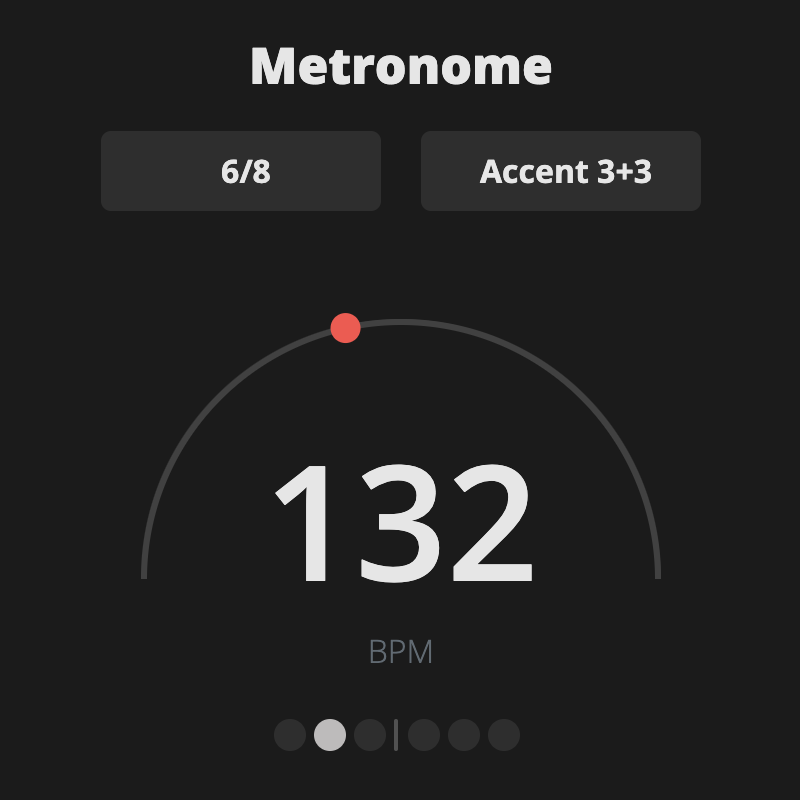<iframe src="https://guitarapp.com/metronome.html?embed=true" title="Online Metronome" style="width: 360px; height:520px; border-style: none; border-radius: 4px;"> </iframe> This free online metronome supports a wide array of time signatures at any tempo and works in any browser. The first thing you'll want to do is set the tempo you want to practice at. Most metronomes default to a setting of 120 BPM which is a common tempo for many styles of music. A list of tempo markings commonly found in classical music notation can be seen below. Tempo is usually set with a tempo control on the metronome but more modern metronomes like ours often provide a tap tempo feature which allows you to tap a few beats at the tempo you desire. In this instance, the metronome calculates the BPM from your tapped beats. More advanced metronomes, like the GuitarApp metronome, also allow you to set the time signature at which you want to practice. Most metronomes will default to a time signature of 4/4 (4 beats per measure) but many other time signatures exist. Waltz time can be achieved by using a time signature of 3/4 (3 beats per measure). Most metronomes also allow the first beat of each measure to be accented so that you can hear the start of each measure more easily. The GuitarApp online metronome also allows for custom accent patterns and complex time signatures such as 7/8 or 10/8 to be selected.

A metronome is a device which is used to help musicians keep accurate timing as they practice or perform music. It does this by producing an audible click or pulse at a regular time interval which is usually referred to as tempo and is measured in BPM (beats per minute). The audible click then serves as a guide for the musician to stay in time and on the beat. Metronomes are particularly useful for early learners who often struggle with keeping time but even professional musicians use metronomes regularly during practice and performance to maintain constant tempo throughout a piece of music. Traditionally metronomes were mechanical devices but these days they are more often electronic devices or software applications.
Beats per minute or BPM is the unit of measurement commonly used for Tempo. A tempo of 120 BPM implies that there will be 120 beats sounded in the duration of one minute. Given that there are 60 seconds in a minute, this equates to two beats per second.
Time signatures play a crucial role in music, providing a framework that organizes musical rhythms and dictates the overall feel and structure of a piece. A time signature is a numeric symbol written at the beginning of a piece of sheet music, typically expressed as a fraction. The top number denotes the number of beats in a measure, while the bottom number represents the note value that receives one beat. For example, in 4/4 time, the top number indicates four beats per measure, and the bottom number indicates that a quarter note receives one beat. This time signature is often referred to as "common time" and is prevalent in a wide range of musical genres. The list below shows all of the time signatures supported by the GuitarApp metronome.
Different time signatures create distinct rhythmic patterns and influences the musical "feel." For instance, a piece in 3/4 time has three beats per measure, often creating a waltz-like or triple meter feel. Setting a metronome to the appropriate BPM for a 3/4 time signature ensures that each beat receives equal timing, guiding musicians to play in a cohesive and coordinated manner. In contrast, a piece in 6/8 time has a "compound meter" with six beats per measure typically divided into 2 groups of 3 beats with an accent at the start of every grouping. Complex time signatures are less common in popular western music but are frequently used in progressive rock, jazz and many forms of traditional music from around the world. In many cases, complex time signatures are often broken into duple, triple and quadruple groupings. For example: 10/8 can be played as a 3+3+2+2 grouping or a 3+2+3+2 grouping givig 2 very different rhythmic feels. There are no explicit rules about rhythmic groupings in complex time signatures which makes them particularly interesting to experiment with. The GuitarApp metronome provides many of the most common groupings for all the complex time signatures.